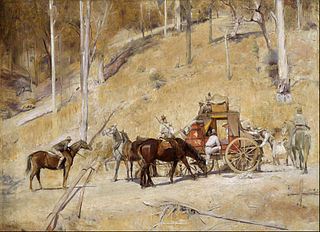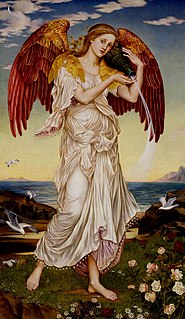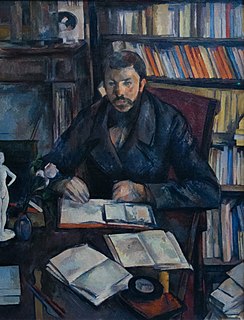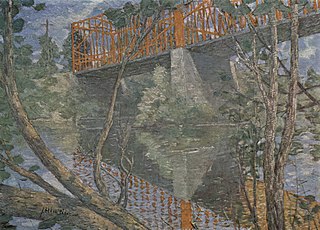 W
WA Friendly Call is an oil on canvas painting executed in 1895 by the American painter William Merritt Chase. It was acquired by the National Gallery of Art in Washington, D.C., in 1943 as part of the Chester Dale collection.
 W
WBailed Up is a 1895 painting by Australian artist Tom Roberts. The painting depicts a stage coach being held up by bushrangers in an isolated, forested section of a back road. The painting is part of the collection of the Art Gallery of New South Wales. and has been described by one former Senior Curator as "the greatest Australian landscape ever painted".
 W
WThe Basket of Apples is a still life oil painting by French artist Paul Cézanne. It belongs to the Helen Birch Bartlett Memorial Collection of the Art Institute of Chicago.
 W
WThe Battle of San Jacinto refers to at least two paintings by Henry Arthur McArdle, depicting the Battle of San Jacinto. One version, measuring approximately 8 feet (2.4 m) by 14 feet (4.3 m), is installed in the Texas Senate chamber of the Texas State Capitol in Austin, Texas. A smaller oil painting, measuring 5 feet (1.5 m) by 7 feet (2.1 m), was discovered in late 2009; this version is not a copy or study for the monumental painting in the Capitol.
 W
WThe Battle of the Roses also known as The Rugby Match or The Roses Match is an 1895 portrait by artist William Barnes Wollen. It is based on the rugby union match between the representative sides of Yorkshire and Lancashire played at Park Avenue, Bradford on 25 November 1893. It depicts the Yorkshire team in the all-white strip attacking while the Lancashire team in the hooped red and white jerseys and black shorts try to prevent a pass being made. The action on the pitch takes place in front of a packed stadium.
 W
WThe Bayswater Omnibus is an 1895 oil painting by George William Joy. It has been held by the Museum of London since 1966. The genre painting depicts a scene inside a horse-drawn omnibus of the London General Omnibus Company. Joy borrowed a bus from the company while he was working on his painting.
 W
WThe Boy in the Red Vest, also known as The Boy in the Red Waistcoat, is a painting by Paul Cézanne, painted in 1889 or 1890. It is a fine example of Cézanne's skilled, nuanced, and innovative mature work after 1880.
 W
WLa Bulaqueña, literally "the woman from Bulacan" or "the Bulacan woman", also sometimes referred to as Una Bulaqueña, is the Spanish title of an 1895 painting by Filipino painter and revolutionary activist Juan Novicio Luna. Bulacan is a province in the Philippines in Luzon island and its residents are called Bulaqueños, also spelled as Bulakenyos in the Filipino language. It is a "serene portrait", of a Filipino woman wearing a María Clara gown, a traditional Filipino dress that is composed of four pieces, namely the camisa, the saya, the pañuelo, and the tapis. The name of the dress is an eponym to María Clara, the mestiza heroine of Filipino hero José Rizal's novel Noli Me Tangere. The woman's clothing in the painting is the reason why the masterpiece is alternately referred to as María Clara. It is one of the few canvases done by Luna illustrating Filipino culture. The painting is displayed at the National Museum of Fine Arts.
 W
WCannon Rock is an 1895 oil painting by Winslow Homer. It is part of the Metropolitan Museum of Art's collection.
 W
WEos is an 1895 painting by Evelyn De Morgan. done in a Pre-Raphaelite style. It depicts the Greek goddess Eos, goddess of the dawn and of love, standing on a seashore, surrounded by birds and flowers and pouring water from a jug.
 W
WFlaming June is a painting by Sir Frederic Leighton, produced in 1895. Painted with oil paints on a 47-by-47-inch square canvas, it is widely considered to be Leighton's magnum opus, showing his classicist nature. It is thought that the woman portrayed alludes to the figures of sleeping nymphs and naiads the Greeks often sculpted.
 W
WFrom Copenhagen Stock Exchange is a monumental group portrait painting by Peder Severin Krøyer, featuring 50 representatives of the Danish commercial and financial industries gathered in the Great Hall of the Exchange Building in Copenhagen, Denmark.
 W
WHam's Redemption, in Portuguese: A Redenção de Cam ; is an oil painting made by the Spanish painter Modesto Brocos in 1895. The work was painted while Brocos was teaching at the National School of Fine Arts of Rio de Janeiro.
 W
WThe Ice Cutters is an 1895 painting by J. Alden Weir, and part of the collection of the Portland Art Museum in Portland, Oregon, in the United States.
 W
WIn a corner on the Macintyre is a 1895 painting by the Australian artist Tom Roberts. The painting is thought to depict the bushranger Captain Thunderbolt in a shootout with police.
 W
WIn a Dublin Park, Light and Shade is an oil on canvas painting by the Irish artist Walter Osborne, completed c. 1895, and housed in the National Gallery of Ireland. The work is renowned for both its harrowing depiction of Dublin's poor at the turn of the 20th century, and its detailing of the effects of light and shadow, and evidences the artist's learning from the French Impressionists.
 W
WJealousy is a painting by Norwegian artist Edvard Munch. Munch returned to this image throughout his whole life - he completed no less than 11 painted versions of Jealousy. The first painting was executed in 1895, and the last was made during the 1930s. Munch also created four lithograph versions and one drypoint of Jealousy.
 W
WJupiter et Sémélé is a painting by the French Symbolist artist Gustave Moreau (1826–1898). It depicts a moment from the classical myth of the mortal woman Semele, mother of the god Dionysus, and her lover, Jupiter, the king of the gods. She was treacherously advised by the goddess Juno, Jupiter's wife, to ask him to appear to her in all his divine splendor. He obliged, but, in so doing, brought about her violent death by his divine thunder and lightning. The painting is a representation of "divinized physical love" and the overpowering experience that consumes Semele as the god appears in his supreme beauty which has been called "quite simply the most sumptuous expression imaginable of an orgasm".
 W
WLachrymae is a late 19th-century painting by British artist Lord Frederic Leighton. Done in oil on canvas, the work depicts a conceptual figure inspired by classical antiquity. Lachrymae is currently in the collection of the Metropolitan Museum of Art.
 W
WMadonna is the usual title given to several versions of a composition by the Norwegian expressionist painter Edvard Munch showing a bare-breasted half-length female figure produced between 1892 and 1895 using oil paint on canvas. He also produced versions in print form.
 W
WThe Mount Kolsaas series of oil paintings was created by the French Impressionist painter Claude Monet in 1895.
 W
WNortheaster is one of several paintings on marine subjects by the late-19th-century American painter Winslow Homer. Like The Fog Warning and Breezing Up, he created it during his time in Maine. It is on display in the Metropolitan Museum of Art in New York. Viewers are presented a struggle of elements between the sea and the rocky shore. Winslow Homer excelled in painting landscape paintings that depicted seascapes and mountain scenery.
 W
WPortrait of Gustave Geffroy is a c. 1895 painting by the French Post-Impressionist artist Paul Cézanne. It portrays Gustave Geffroy, a French novelist and art critic noted as one of the earliest historians of Impressionism. In March 1894, Geffroy wrote a sympathetic article in the periodical Le Journal praising the work of painter Paul Cézanne who until then had received little praise in critical circles. Mutual friend Claude Monet arranged for a meeting between the two in November of that year which ended abruptly due to Cézanne's oft-noted erratic behavior. Nonetheless, Geffroy continued to write favorably of Cézanne, believing, "He is a great teller of truth. Passionate and candid, silent and subtle, he will go to The Louvre." Cézanne expressed thanks in letters to Geffroy in the months following their meeting and, in a display of gratitude, he elected to paint Geffroy's portrait.
 W
WPortrait of Maud Cook is an 1895 painting by the American artist Thomas Eakins, Goodrich catalogue #279. It is in the collection of the Yale University Art Gallery.
 W
WThe Red Bridge is a late 19th-century painting by American artist Julian Alden Weir. Done in oil on canvas, Red Bridge has been cited as an excellent example of Weir's Japanese-inspired style of impression. The painting is in the collection of the Metropolitan Museum of Art.
 W
WTampuhan, meaning "sulking", is an 1895 classic oil on canvas impressionist painting by Filipino painter and revolutionary activist Juan Luna. It depicts a Filipino man and a Filipino woman having a lovers' quarrel.
 W
WSowing and Harvesting and Market, popularly referred to as the Vršac triptych, is a three-panel oil painting by the Serbian realist Paja Jovanović. Painted around 1895, it shows the everyday interactions of the inhabitants of Vršac, a multi-ethnic and multi-religious town in the Banat region of Austria-Hungary of which Jovanović was a native. The painting was commissioned by the Vršac city council in 1895 for the following year's Budapest Millennium Exhibition.
 W
WWoman Reading is a painting by Henri Matisse from 1896. It is displayed at Le Cateau-Cambrésis, Musée Matisse, deposited by the Centre Pompidou in 2002. It shows the calmness of a reading woman. The painting evokes a calm, relaxing atmosphere.
 W
WThe Young Sabot Maker is an oil on canvas painting made by Henry Ossawa Tanner in 1895. Measuring 47 3/8 x 35 3/8 inches, the painting was purchased by The Nelson-Atkins Museum of Art in 1995. The painting depicts an older man proudly watching a boy push with his weight against the crossbar handle of a sawhorse to carve a sabot, or wooden shoe. The two figures stand within the sabot maker's workshop, wood shavings scattered around them on the floor.